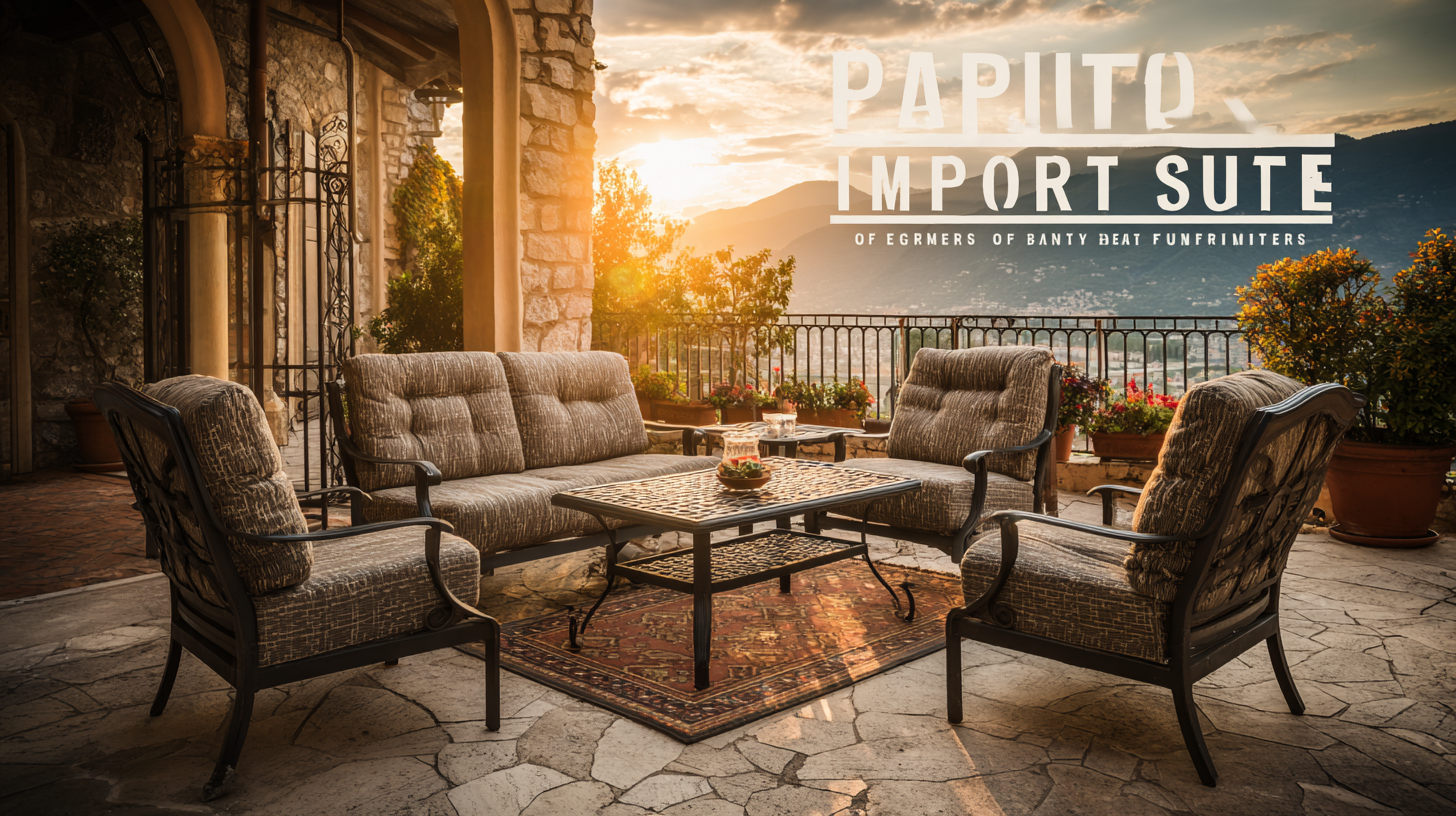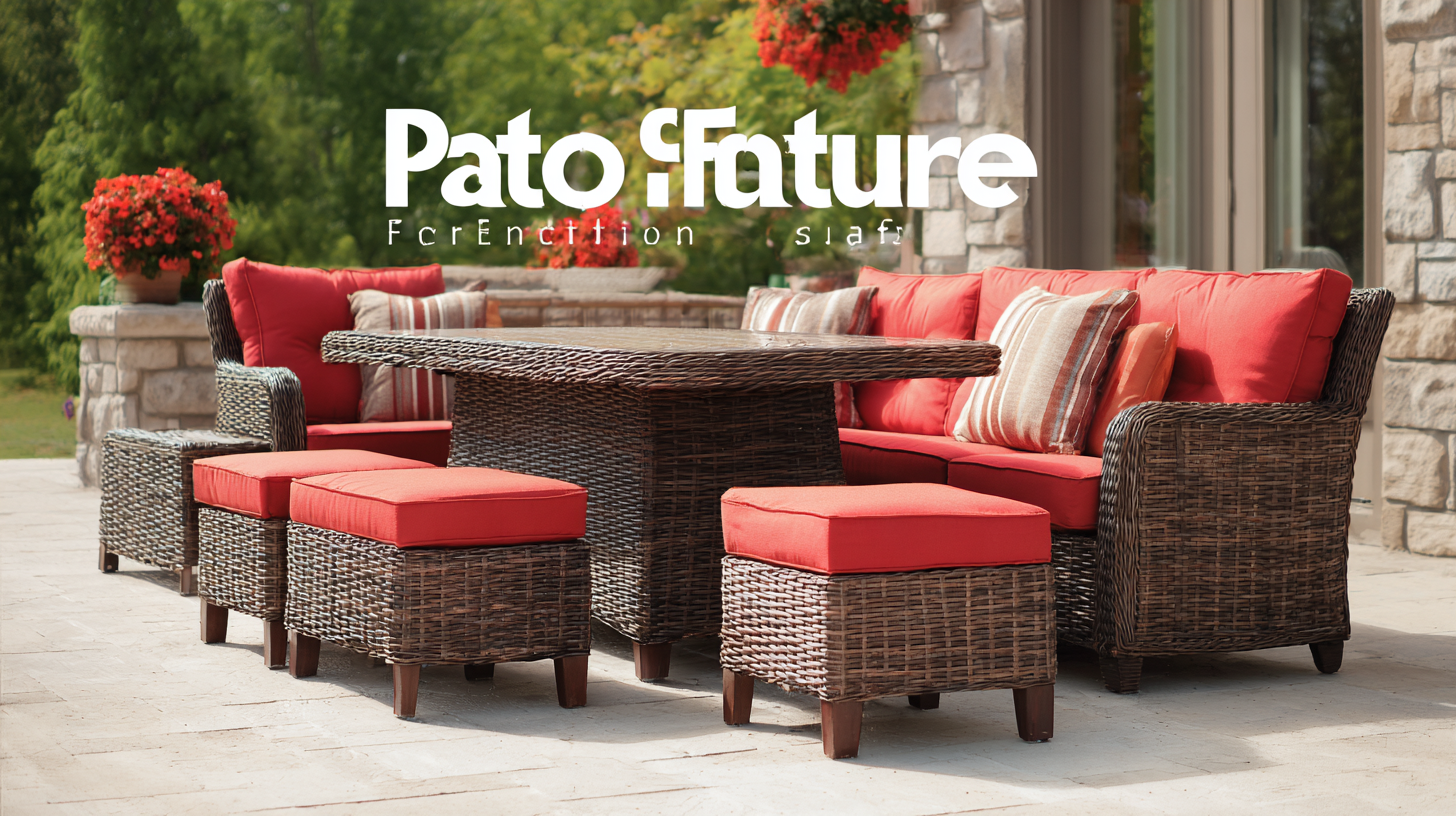Web Menu
Product Search
Exit Menu
How to Navigate Import and Export Certifications for the Best Patio Furniture Sets: Essential Industry Insights
The patio furniture sets market has seen a significant surge in popularity, driven by a growing emphasis on outdoor living spaces and the rising demand for versatile home furnishings. According to a recent report from Grand View Research, the global outdoor furniture market is expected to reach $30.6 billion by 2025, highlighting the potential for increased trade opportunities in this sector.

As businesses navigate the complexities of import and export certifications, understanding the regulatory landscape becomes essential for staying competitive. Proper certification not only ensures compliance but also enhances product credibility and consumer trust. This blog will explore the essential industry insights on import and export certifications specifically tailored for patio furniture sets, guiding manufacturers and retailers through the intricacies of the certification process while identifying alternative compliance strategies to optimize their market reach.
Understanding Import Regulations for Patio Furniture: Key Compliance Factors
When importing patio furniture, understanding the compliance factors is crucial for ensuring that your products meet safety and quality standards. The import regulations often vary by country, so it's essential to familiarize yourself with the specific requirements in your target market. Common regulations include adherence to safety certifications, material specifications, and labeling requirements. For example, in the United States, patio furniture must comply with the Consumer Product Safety Commission (CPSC) regulations, which dictate safety standards for outdoor furniture materials, flammability, and durability.
Additionally, documentation plays a pivotal role in the importation process. Properly filled customs forms, invoices, and certificates of origin can expedite the clearance process. It’s vital to verify that the manufacturer has valid certifications, such as ISO or ASTM, to boost consumer confidence in your products. Ignoring these compliance factors can lead to delays, fines, or even product recalls, which underscores the importance of thorough research and planning before making import decisions. By prioritizing these regulatory requirements, importers can effectively navigate the complex landscape of patio furniture certifications and ensure a smoother entry into the market.

Export Requirements: What to Consider When Selling Patio Furniture Internationally
When considering the export of patio furniture to international markets, especially the United Arab Emirates (UAE), it's crucial to navigate the specific requirements outlined for successful international trade. The UAE stands as the UK's largest export market in the Middle East, with a total trade value surpassing £2 billion in furniture-related products alone. This market is particularly promising due to the country's growing demand for high-quality outdoor furnishings, driven by a booming tourism sector and a rapidly expanding middle class seeking to enhance their living spaces.
Exporters must be aware of the key certifications and regulations that govern the sale of patio furniture. Compliance with both local and international standards is essential, given the UAE's strict import regulations. For instance, ensuring that products meet safety and health regulations can determine successful entry into this lucrative market. Moreover, understanding the implications of global trade policies, such as tariffs and trade agreements, is vital for pricing strategy and competitiveness. With the right information, exporters can strategically position their offerings and capitalize on the vibrant UAE market while navigating the complexities inherent in international trade.
Essential Certifications: Navigating Quality Standards for Outdoor Furniture
When shopping for patio furniture, understanding essential certifications is crucial in ensuring you select high-quality outdoor pieces. According to a 2022 report from the American Society for Testing and Materials (ASTM), nearly 30% of consumer complaints regarding outdoor furniture arise from issues related to material quality and durability. Proper certifications, such as ANSI (American National Standards Institute) and ISO (International Organization for Standardization), serve as indicators of compliance with rigorous industry standards, ensuring that your furniture can withstand various weather conditions.
Moreover, a study by the Outdoor Furniture Manufacturers Association (OFMA) highlighted that products meeting these certifications are 20% more likely to have a longer lifespan compared to uncertified alternatives. These standards address key performance criteria, including resistance to UV exposure, moisture, and mechanical stress. As consumers become more informed, the demand for certified patio furniture sets is expected to grow, with a projected market increase of 15% by 2025, driven by the desire for reliable and sustainable outdoor living solutions. Ignoring these certifications could result in poor investment, as unverified products often lead to dissatisfaction and additional costs over time.
Import and Export Certifications for Patio Furniture Sets
This chart illustrates the number of certifications required for various quality standards in the patio furniture industry. Understanding these certifications can help manufacturers and consumers ensure that outdoor furniture meets essential quality and safety standards.
Market Insights: Analyzing the Global Demand for Patio Furniture Trends
The global demand for patio furniture continues to evolve, driven by changing consumer preferences and lifestyle trends. As outdoor living spaces gain prominence, homeowners are increasingly seeking high-quality, stylish furniture that enhances their outdoor experiences. Recent market analysis indicates a significant shift towards eco-friendly materials and sustainable manufacturing processes, reflecting an overall trend of environmental consciousness among consumers. Brands that prioritize sustainability are not only appealing to a more discerning demographic but are also reaping the benefits of brand loyalty in a competitive market.
Additionally, the rise of e-commerce has transformed the way consumers shop for patio furniture. Online platforms are becoming the primary avenue for discovering and purchasing outdoor furniture sets, offering customers convenience and a wider selection than traditional retail stores. Social media also plays a crucial role, with inspiring images and trends shared across various platforms, driving consumer interest in outdoor aesthetics. As brands navigate this dynamic landscape, understanding these trends is essential for staying ahead in the market and meeting the evolving demands of consumers eager to create perfect outdoor retreats.
Tips for Ensuring Sustainable Sourcing in Patio Furniture Manufacturing
When exploring patio furniture manufacturing, sustainable sourcing should be a top priority for both manufacturers and consumers. To ensure that the materials used in furniture production are environmentally responsible, start by sourcing wood from certified sustainable forests. Organizations like the Forest Stewardship Council (FSC) provide guidelines and certifications that guarantee the wood is harvested responsibly, helping to preserve ecosystems and biodiversity.

In addition to wood, consider the sourcing of metals and fabrics used in patio furniture. Opt for recycled materials when possible, as they reduce the need for virgin resources and minimize waste. Moreover, verify that the fabrics are made from eco-friendly fibers such as organic cotton or recycled polyester. These materials not only provide durability but also align with sustainable practices, offering a healthier option for both consumers and the environment. By prioritizing sustainable sourcing, manufacturers can create high-quality patio furniture sets that appeal to eco-conscious buyers while contributing positively to the planet.
-
- about us
- About Us
- Qualification
- Privacy
-
- Packaging products
- Hot Sale
- Outdoor Sofa Sets
- Outdoor Dining Sets
- Outdoor Loungers/Sunbeds
- Swing Chairs
- Single Chair

 English
English España
España عرب
عرب 简体中文
简体中文